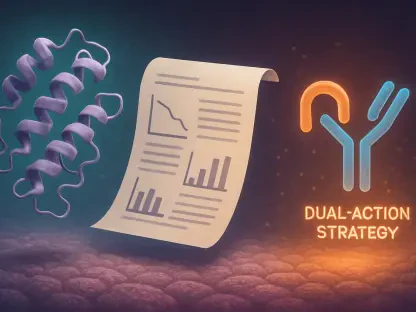In an era where the pharmaceutical industry grapples with skyrocketing costs and prolonged timelines for bringing new drugs to market, computer-aided drug discovery (CADD) emerges as a transformative force poised to redefine the landscape over the next decade. This innovative approach harnesses computational tools, simulations, and algorithms to identify and optimize potential drug candidates, slashing both the financial burden and duration of traditional methods. From streamlining target identification to predicting drug interactions with pinpoint accuracy, CADD offers a glimpse into a future where efficiency and precision dominate drug development. As the global demand for novel therapeutics intensifies amid rising chronic disease rates, the role of CADD in accelerating research and development becomes not just significant but essential. This exploration delves into the anticipated evolution of CADD from 2025 to 2035, shedding light on technological breakthroughs, market dynamics, and the challenges that lie ahead in this rapidly advancing field.
Emerging Technologies in CADD
AI and Machine Learning Integration
The integration of artificial intelligence (AI) and machine learning (ML) into CADD platforms stands as a game-changer for drug discovery in the coming years. These technologies bring unprecedented precision to the prediction of drug-target interactions, allowing researchers to sift through millions of compounds to pinpoint those with the highest therapeutic potential. By learning from vast datasets of chemical and biological information, AI and ML models can forecast outcomes of complex molecular behaviors that would otherwise take years to uncover through conventional experimentation. This capability not only speeds up the identification of viable drug candidates but also reduces the likelihood of late-stage failures in clinical trials. As these tools evolve, their ability to adapt and refine predictions based on real-time data will further cement their importance in the pharmaceutical toolkit.
Beyond prediction, AI and ML are driving a paradigm shift toward personalized medicine within the realm of CADD. These advanced systems can simulate how different genetic profiles might respond to specific treatments, enabling the design of therapies tailored to individual patients. This marks a significant departure from the one-size-fits-all approach, addressing the unique needs of diverse populations with greater efficacy. Such customization is particularly vital for tackling complex conditions like cancer or rare genetic disorders, where standard treatments often fall short. The continuous improvement of algorithms through iterative learning processes ensures that CADD platforms will become even more adept at handling intricate biological variables, positioning AI and ML as indispensable allies in the quest for innovative healthcare solutions over the next decade.
Big Data Analytics
Big data analytics is rapidly becoming a cornerstone of CADD, offering the computational power to process and interpret enormous volumes of biological and chemical data. This technology enables researchers to uncover hidden patterns and correlations that are critical for identifying novel therapeutic targets and optimizing drug designs. By integrating data from diverse sources such as genomic studies, clinical trials, and chemical libraries, big data tools provide a comprehensive view of the drug discovery landscape. This holistic approach allows for more informed decision-making, ensuring that only the most promising compounds advance to experimental stages. As data generation continues to accelerate, the role of analytics in managing and extracting value from this information will grow increasingly pivotal.
Moreover, the application of big data in CADD extends to enhancing the understanding of disease mechanisms at a molecular level. By analyzing intricate datasets, researchers can map out pathways and interactions that contribute to various conditions, paving the way for targeted interventions. This depth of insight is particularly valuable in addressing multifaceted diseases where multiple factors interplay, such as neurodegenerative disorders or metabolic syndromes. The ability to cross-reference historical data with current findings also aids in predicting potential side effects and toxicity issues early in the development process, saving significant time and resources. As big data tools become more sophisticated, their integration with CADD promises to unlock breakthroughs that were once deemed unattainable, shaping a future of more effective and safer medications.
Market Trends and Growth Opportunities
Precision Medicine and Personalization
The push toward precision medicine is set to be a defining trend in the evolution of CADD over the forecast period from 2025 to 2035. This approach focuses on crafting treatments that align with an individual’s genetic makeup, lifestyle, and environmental factors, moving away from generic solutions. CADD plays a crucial role by employing computational models to simulate how specific molecular structures interact with unique biological profiles, ensuring higher efficacy and fewer adverse effects. This tailored strategy is especially significant in fields like oncology, where personalized therapies can target mutations specific to a patient’s tumor. As healthcare increasingly prioritizes individualized care, the reliance on CADD to design bespoke drugs will likely intensify, heralding a new era of therapeutic innovation.
Additionally, the synergy between precision medicine and CADD extends to improving patient outcomes through better trial design and drug optimization. Computational tools can predict how different demographics might respond to a drug, enabling researchers to refine formulations before clinical testing begins. This predictive power not only enhances the likelihood of trial success but also addresses disparities in treatment effectiveness across populations. By focusing on the nuances of genetic and molecular diversity, CADD facilitates the development of therapies that cater to underrepresented groups, fostering inclusivity in healthcare advancements. The growing emphasis on personalization underscores the potential for CADD to bridge gaps in current medical practices, making treatments more accessible and impactful in the years ahead.
Geographic and Industry Expansion
Geographic diversification is anticipated to significantly influence the growth trajectory of CADD, with regions like North America, Europe, and Asia-Pacific emerging as key centers of innovation. The United States, bolstered by a robust pharmaceutical industry and substantial R&D investments, is expected to maintain a leading position in adopting and advancing CADD technologies. Meanwhile, countries like Germany showcase strong academic and industrial collaboration, further driving progress. In Asia-Pacific, nations such as China and India are witnessing rapid growth due to increased healthcare spending and a rising demand for cutting-edge therapeutics. This global spread of CADD adoption reflects a shared recognition of its value in addressing pressing medical needs across varied economic landscapes.
Parallel to geographic expansion, the industry itself is experiencing a surge in CADD integration across pharmaceutical and biotechnology sectors. Companies are increasingly embedding computational tools into their workflows to enhance efficiency and competitiveness, recognizing that speed to market can be a decisive factor in an industry with high stakes. Collaborative efforts between these sectors and technology providers are also on the rise, fostering innovation through shared expertise and resources. Such partnerships often result in the development of more advanced CADD platforms capable of tackling complex challenges in drug discovery. As adoption spreads, the collective push toward leveraging CADD will likely create a dynamic ecosystem where innovation thrives, ensuring sustained growth and transformative impact on global health outcomes through 2035.
Challenges and Barriers to Adoption
High Costs and Expertise Gaps
One of the primary obstacles facing the widespread adoption of CADD is the substantial initial investment required for software, hardware, and infrastructure. These high upfront costs can be particularly prohibitive for smaller pharmaceutical companies or startups with limited budgets, potentially widening the gap between industry leaders and emerging players. While the long-term benefits of reduced R&D expenses and faster drug development are clear, the financial barrier to entry remains a significant concern. Addressing this challenge will require innovative pricing models or subsidies to democratize access to CADD tools, ensuring that a broader range of organizations can harness their potential. Without such measures, the risk of market consolidation among well-funded entities looms large, limiting diversity in drug discovery approaches.
Compounding the issue of cost is the critical shortage of skilled professionals capable of operating complex CADD systems. The technology demands a deep understanding of computational chemistry, bioinformatics, and data analysis, fields where trained experts are in short supply. This expertise gap can hinder the effective implementation of CADD, as even the most advanced tools are rendered ineffective without competent users. Industry and academic institutions must prioritize training programs and interdisciplinary education to build a workforce equipped to handle these sophisticated platforms. Bridging this gap is essential for maximizing the benefits of CADD, as human capital remains a cornerstone of translating technological advancements into tangible healthcare solutions over the coming decade.
Integration and Regulatory Hurdles
Integrating CADD tools into existing drug discovery workflows presents a complex challenge, often requiring substantial modifications to established processes. Many organizations face difficulties in aligning computational methods with traditional laboratory practices, leading to inefficiencies and resistance to change among research teams. This integration process can be time-consuming and resource-intensive, particularly for companies with legacy systems that are not easily compatible with modern CADD software. Overcoming these operational hurdles necessitates strategic planning and investment in change management to ensure a seamless transition. Without such efforts, the full potential of CADD to streamline drug development may remain underutilized, slowing overall progress in the field.
Additionally, the evolving regulatory landscape surrounding computational drug discovery introduces another layer of uncertainty for stakeholders. As CADD becomes more integral to pharmaceutical research, regulatory bodies are likely to develop new guidelines to ensure the validity and safety of computationally derived drug candidates. These frameworks, while necessary, could impose additional compliance burdens on companies, potentially delaying the adoption of innovative tools. Proactive engagement with regulators to shape policies that balance innovation with safety will be crucial for the industry. Navigating these regulatory shifts effectively will determine how quickly and confidently CADD can be integrated into mainstream drug development, influencing its impact on healthcare advancements through 2035.
Reflecting on Transformative Pathways
Looking back, the journey of computer-aided drug discovery has already begun to reshape pharmaceutical research by tackling inefficiencies and fostering innovation through computational precision. The strides made in integrating AI, machine learning, and big data analytics have laid a robust foundation for personalized medicine and streamlined drug development processes. Challenges such as high costs, expertise shortages, and regulatory complexities have been acknowledged as critical barriers that need persistent attention. Moving forward, the focus should pivot toward actionable strategies like fostering public-private partnerships to lower financial barriers and expanding educational initiatives to build a skilled workforce. Encouraging dialogue between industry leaders and regulatory bodies will also be vital to create adaptive frameworks that support CADD’s growth. By prioritizing these steps, the legacy of this decade can be one of transformative health solutions, ensuring that the promise of faster, more effective drug discovery becomes a lasting reality for generations to come.









